Etidronic Acid
Synonym(s):1-Hydroxyethane-1,1,-diphosphonic acid;1-Hydroxyethylidenediphosphonic acid;HDEPA;HEDP;OEDFK
- CAS NO.:2809-21-4
- Empirical Formula: C2H8O7P2
- Molecular Weight: 206.03
- MDL number: MFCD00070585
- EINECS: 220-552-8
- SAFETY DATA SHEET (SDS)
- Update Date: 2025-12-17 09:49:47
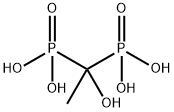
What is Etidronic Acid?
Absorption
Etidronic acid has an oral bioavailability of 1-10%. Further data regarding pharmacokinetics of etidronic acid are not readily available.
Toxicity
Patients experiencing an overdose may present with hypocalcemia, vomiting, parasthesia, and diarrhea. Overdose can be treated with symptomatic and supportive treatment that may include management of electrolyte imbalances and intravenous calcium gluconate.
Description
Hydroxyethylidene diphosphonic acid (HEDP) is a new type of chlorine-free electroplating complexing agent. It is used as the main agent for stable water quality in the circulating cooling water system, and plays the role of corrosion and scale inhibition. This product is one of the organic polyphosphonic acid-free water tablet conditioners. There are also some other varieties of such products produced in China, such as aminotrimethylenephosphonic acid (ATMP): [CH2PO(OH)2]3N and ethyl acetate Diaminetetramethylenephosphoric acid (EDTMP) and so on. Organic polyphosphonic acid is a type of water treatment agent developed in the late 1960s and confirmed around the 1970s.
Chemical properties
light beige powder
Originator
Etidron,Gentili,Italy,1977
The Uses of Etidronic Acid
Etidronate (Didronel) is a human protein tyrosine phosphatase inhibitor with IC50 of 0.2 μM.
The Uses of Etidronic Acid
1-Hydroxyethylidenebis(phosphonic acid) acts as human protein tyrosine phosphatase inhibitor. It is also useful for photographic applications. It finds application to strengthen bone, osteoporosis treatment and to treat Paget's disease of bone. In addition, it is used in corrosion inhibition in circulating cool water systems, oil fields and low-pressure boilers with electric power, the chemical industry, metallurgy and fertilizers. It is also utilized for formulating reverse osmosis and thermal desalination anti-scaling agents. Furthermore, it is used in detergents, water treatment, cosmetics and pharmaceuticals.
Indications
Etidronate is indicated to treat Paget's disease of bone, as well as the treatment and prevention of heterotropic ossification after total hip replacement of spinal cord injury.
Background
Etidronic acid is a first generation bisphosphonate similar to clodronic acid and tiludronic acid. These drugs were developed to mimic the action of pyrophosphate, a regulator of calcification and decalcification. Etidronate’s use has decreased over the years in favor of the third generation, nitrogen containing bisphosphonate zoledronic acid, ibandronic acid, minodronic acid, and risedronic acid.
Etidronic acid was granted FDA approval on 1 September 1977.
What are the applications of Application
Etidronic acid is a diphosphonate which affects calcium metabolism
Definition
ChEBI: A 1,1-bis(phosphonic acid) that is (ethane-1,1-diyl)bis(phosphonic acid) having a hydroxy substituent at the 1-position. It inhibits the formation, growth, and dissolution of hydroxyapatite crystals by chemisorption to calcium phosphate surfaces.
Manufacturing Process
Phosphorous acid was premixed with acetic acid to form a 50 wt % solution of phosphorous acid dissolved in acetic acid. The acids were mixed on a molar basis of 1.36:1, acetic acid to phosphorous acid, and this corresponded on a mol percentage basis to 57.6% acetic acid and 42.4% phosphorous acid. Acetic anhydride was continuously metered into a stream of the phosphorous acid-acetic acid mixture to form the reaction solution. The acetic anhydride was metered into the acid mixture at a mol ratio of 1.33 mols of acetic anhydride per mol of phosphorous acid. The metering rates were 18.5 lb/hr of the phosphorous acid/acetic acid premixed solution and 15.1 lb/hr acetic anhydride. The reaction solution was continuously passed through a heat exchanger where it was heated to 190°F then it was continuously fed into a two stage back-mix reaction zone where due to the heat of reaction the temperature rose to 275°F. The average residence in the reaction zone was 27 min. The reaction zone consisted of two back-mix reactors each having a capacity of 7.5 pounds of the reaction solution. A stream of reaction solution was continuously with drawn from the second reactor and continuously mixed with a stream of water which was being metered at a rate of 2 lb/hr. This amount of water corresponded to 18% excess over the theoretical amount necessary to hydrolyze all of the acetyl-containing compounds in the reaction solution to free acids. The hydrolyzed solution was continuously passed through a heat exchanger and cooled to room temperature after which the solution was continuously passed to a crystallizer where, with agitation, the ethane-1-hydroxy-1,1-diphosphonic acid crystallized. The slurry was then filtered and the crystals were recovered and dried. Analysis of the product showed a conversion rate of phosphorous acid to ethane-1-hydroxy-1,1- diphosphonic acid of 86%. Sodium hydroxide may be used to give the disodium salt.
brand name
Didronel (Millot Laboratories, France); Didronel (Procter & Gamble).
Therapeutic Function
Bone calcium regulator
Flammability and Explosibility
Not classified
Pharmacokinetics
Etidronic acid is a first generation bisphosphonate that inhibits the action of osteoclasts, preventing bone resporption. It has a wide therapeutic index as overdoses are not associated with severe toxicity and a long duration of action as it slowly releases from the bone. Patients should be counselled regarding the risk of upper gastrointestinal adverse reactions.
Metabolism
Etidronic acid is not metabolized in vivo
Properties of Etidronic Acid
| Melting point: | 198~199℃ |
| Boiling point: | 578.8±60.0 °C(Predicted) |
| Density | 1.45 (60% aq.) |
| vapor pressure | 0Pa at 25℃ |
| storage temp. | Sealed in dry,Room Temperature |
| solubility | Methanol (Slightly), Water (Slightly) |
| pka | 1.35, 2.87, 7.03, 11.3(at 25℃) |
| form | Powder |
| color | white |
| PH | pH (1.7→100, 25℃) : 1.3~1.8 |
| Water Solubility | Soluble in water. |
| Merck | 14,3863 |
| BRN | 1789291 |
| Stability: | Stable. Incompatible with strong oxidizing agents. |
| CAS DataBase Reference | 2809-21-4(CAS DataBase Reference) |
| EPA Substance Registry System | Etidronic acid (2809-21-4) |
Safety information for Etidronic Acid
| Signal word | Danger |
| Pictogram(s) |
 Corrosion Corrosives GHS05 |
| GHS Hazard Statements |
H290:Corrosive to Metals H318:Serious eye damage/eye irritation |
| Precautionary Statement Codes |
P280:Wear protective gloves/protective clothing/eye protection/face protection. |
Computed Descriptors for Etidronic Acid
| InChIKey | DBVJJBKOTRCVKF-UHFFFAOYSA-N |
Etidronic Acid manufacturer
New Alliance Fine Chem Private Limited
Brijesh Chemicals
Kalpatharu Chemicals
New Products
4,4-Difluoropiperidine hydrochloride tert-butyl 9-methoxy-3-azaspiro[5.5]undecane-3-carboxylate Indole Methyl Resin N-Isopropylurea N,N-Dicyclohexylcarbodiimide(DCC) MELDRUMS ACID 5-METHYLISOXAZOLE-4-CARBOXYLIC ACID Magnessium Bis glycinate Zinc ascorbate 1-bromo-2-butyne 2-acetamidophenol 9(10H)-anthracenone Erythrosin B, 4-Piperidinopiperidine 2-((4-morpholinophenylamino) (methylthio) methylene) malononitrile 2,4-dihydroxybenzaldehyde 3-(4-morpholinophenylamino)-5-amino-1H-pyrazole-4-carbonitrile Methyl 2-methylquinoline-6-carboxylate 2,6-dichloro-4-nitropyridine 4-Bromo-2-chlorobenzonitrile 2-(benzylamino)acetic acid hydrochloride 4-(tert-Butoxycarbonylamino)but- 2-ynoic acid 3,4-dihydro-2H-benzo[b][1,4]dioxepine 1-Phenyl-1-cycloprppanecarboxylicacidRelated products of tetrahydrofuran
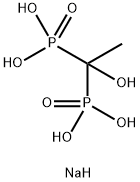
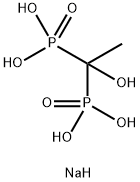




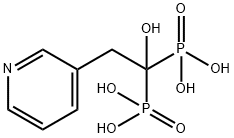
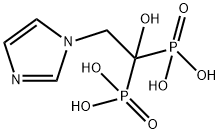
You may like
-
 1-Hydroxyethylidenebis (phosphonic acid) CAS 2809-21-4View Details
1-Hydroxyethylidenebis (phosphonic acid) CAS 2809-21-4View Details
2809-21-4 -
 1-Hydroxyethylidenebis (phosphonic acid) CAS 2809-21-4View Details
1-Hydroxyethylidenebis (phosphonic acid) CAS 2809-21-4View Details
2809-21-4 -
 Etidronic acid 60% aqueous solution CAS 2809-21-4View Details
Etidronic acid 60% aqueous solution CAS 2809-21-4View Details
2809-21-4 -
 1-Hydroxy Ethylidene-1,1- Diphosphonic Acid 50%, Packaging Size: 65 KgsView Details
1-Hydroxy Ethylidene-1,1- Diphosphonic Acid 50%, Packaging Size: 65 KgsView Details
2809-21-4 -
 Chemical Processing HEDP 60%, Packaging Type: Hdpe Drum, Grade Standard: Technical GradeView Details
Chemical Processing HEDP 60%, Packaging Type: Hdpe Drum, Grade Standard: Technical GradeView Details
2809-21-4 -
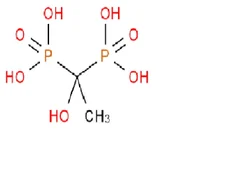 1-Hydroxy Ethylidene-1, 1-Diphosphonic Acid, LiquidView Details
1-Hydroxy Ethylidene-1, 1-Diphosphonic Acid, LiquidView Details
2809-21-4 -
 Scale Inhibitor RO Membrane Treatment Chemicals HEDP -Hydroxyethylidene Diphosphonic Acid, Chemical Formula: C2H8O7P2, LiquidView Details
Scale Inhibitor RO Membrane Treatment Chemicals HEDP -Hydroxyethylidene Diphosphonic Acid, Chemical Formula: C2H8O7P2, LiquidView Details
2809-21-4 -
 White Crystal Crystals HEDP 60 CAS: 2809-21-4, Grade Standard: Technical GradeView Details
White Crystal Crystals HEDP 60 CAS: 2809-21-4, Grade Standard: Technical GradeView Details
2809-21-4
